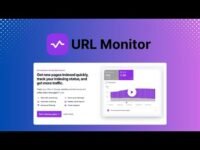TL;DR:URL Monitor is a tool that streamlines the Google indexing process, providing insights into page status and enabling efficient submission for indexing.
In today’s digital landscape, having your web pages indexed on Google is crucial for driving traffic and improving visibility. URL Monitor is a valuable tool that simplifies the indexing process and ensures that your pages are efficiently crawled by search engines. Join me as I guide you through the steps of leveraging URL Monitor to enhance your site’s indexing performance.
Introduction to URL Monitor
As a website owner, ensuring that my pages are properly indexed by search engines is crucial for maximizing my site’s visibility and attracting organic traffic. In this section, I will delve into the significance of indexing for SEO, introduce the URL Monitor tool, and explain the process of signing up and connecting with a Google account.
Overview of the Importance of Indexing for SEO
Indexing plays a pivotal role in SEO optimization as it determines how easily search engines like Google can discover and display our web pages in search results. When a page is indexed, it becomes part of the search engine’s database, making it eligible to appear in relevant search queries. The more pages indexed, the higher the chances of increasing impressions and driving traffic to the site.
Introduction to URL Monitor and Its Benefits
URL Monitor is a powerful tool designed to streamline the process of getting new pages indexed in Google efficiently. By providing daily checks on the index status, it notifies me promptly if any pages drop out of the Google index. This proactive monitoring ensures that all valuable pages remain visible to users, contributing to enhanced site visibility and improved SEO performance.
Signing Up and Connecting with Google Account
To harness the capabilities of URL Monitor, the initial step involves signing up for the tool and connecting it with a Google account. By linking the tool with my Google account, URL Monitor seamlessly integrates with Google Search Console, pulling in a comprehensive list of all my sites for monitoring and indexing purposes. This synchronization enables the tool to fetch sitemaps, pages, and analytics data, providing valuable insights into the indexing status of my web pages.

Enabling Features and Site Activation
As I delve deeper into optimizing my site’s performance and visibility, I encounter a range of features that enhance the functionality of the URL Monitor tool. One such feature is the Diamond Size Chart, which, when activated, unlocks a myriad of additional options for me to explore. While I choose to defer granting access and auto-indexing for now, I focus on navigating through the details section to maximize the tool’s capabilities.
Upon activating a site, the URL Monitor tool seamlessly fetches sitemaps and pages from Google Search Console, providing me with real-time updates through a dynamic table display. In cases where a sitemap is unavailable, I have the flexibility to manually add pages by a simple click on the “Add Pages” button, ensuring comprehensive coverage of my site’s content.
Given the substantial volume of pages on my site, amounting to 11,000, the tool imposes a limit on checking a maximum of 2,000 pages within a 24-hour timeframe. While this limitation poses a challenge, I anticipate addressing it in a future endeavor, showcasing innovative workarounds to streamline the indexing process.
For expansive sites like mine, where exhaustive page checking is unfeasible in a single sweep, the tool leverages analytics data from Search Console to identify pages with recent impressions. These impressions serve as a reliable indicator of potential indexing, denoted by a reassuring green checkmark in the table, affirming the pages’ visibility in Google search results.
Despite not individually scrutinizing these pages, the impressions data offers a reliable proxy for their indexing status. Furthermore, the tool furnishes insightful statistics on the number of indexed pages, paving the way for a comprehensive verification of their indexing status in due course.
Upon the completion of all tasks, I leverage the tool’s filtering capabilities to pinpoint pages of interest, particularly those that remain unindexed. Additionally, the tool conducts health checks to flag pages encountering impediments to indexing, furnishing vital information on sitemaps, last checked timestamps, Google crawl history, and selected canonical URLs.
Returning to the sites page, a conspicuous red box under “Grant Access” prompts me to add the tool’s accounts as owners to my Google Search Console property. By adhering to the prescribed steps and granting owner permissions to these accounts, I empower myself to submit up to 200 URLs daily for indexing, with the flexibility to revoke access at my discretion.
Upon successful integration of accounts, I verify their active status and contemplate the option of adding a secondary account to broaden the scope of indexed pages. While the auto-index option remains disabled for the present, I navigate towards the details section to delve deeper into optimizing site activation.
By sieving through the list of unindexed pages, I curate a selection for submission, witnessing them promptly listed under the “Submitted” filter with pertinent submission timestamps. Despite exhausting the daily quota, I remain optimistic about Google’s prioritization of these submissions, bolstering the likelihood of their swift indexing.
URL Monitor transcends its role as a mere indexing tool, doubling up as a robust technical SEO instrument for monitoring and tracking pages at scale. Its efficacy in identifying high-value pages and rectifying indexing discrepancies underscores its pivotal role in sustaining site traffic and visibility.
I extend a warm invitation to you to explore the capabilities of URL Monitor and share your invaluable feedback. Embrace this tool as a cornerstone of your site’s health and efficiency, ensuring seamless indexing and heightened visibility across the digital landscape.

Checking Index Status and Analytics Data
As I delve into the realm of monitoring index status and leveraging analytics data, I realize the pivotal role these play in enhancing the visibility and efficiency of my website. With the aid of tools like URL Monitor, I can seamlessly track the indexing progress of my pages on Google, ensuring optimal SEO optimization and site visibility.
Monitoring Index Status for Pages
One of the key aspects of maintaining a well-indexed website is regularly monitoring the index status of pages. With URL Monitor, I can effortlessly keep track of which pages are indexed and receive timely notifications if any pages drop out of the Google index. This proactive approach allows me to address any indexing issues promptly, thus maximizing the impressions and traffic potential of my site.
Utilizing Analytics Data to Identify Indexed Pages
Analytics data serves as a valuable resource in identifying indexed pages, especially for large websites with a vast number of pages. By analyzing the data provided by URL Monitor, I can pinpoint pages that have had impressions in the last 30 days, indicating their potential indexing status. This data-driven approach not only streamlines the indexing process but also offers insights into the performance of individual pages, guiding strategic SEO decisions.
Understanding the Indexing Process for Large Sites
Managing indexing for large sites can be a complex task, given the sheer volume of pages involved. URL Monitor simplifies this process by fetching analytics data from Search Console, highlighting pages with impressions for quick identification of indexed content. This streamlined approach not only saves time but also ensures that all pages are eventually checked for indexing status, maintaining the site’s overall health and visibility.

Submitting Pages for Indexing
As I delve deeper into the world of SEO optimization, one crucial aspect that I focus on is submitting pages for indexing. This process plays a significant role in enhancing site visibility and maximizing the chances of page prioritization by Google.
One of the key steps in this process is identifying not indexed pages for submission. This is where the URL Monitor tool proves to be invaluable. By utilizing this tool, I can quickly pinpoint pages that have not been indexed by Google, allowing me to take proactive measures to rectify this issue.
Submitting pages for indexing through the URL Monitor tool is a seamless process. Upon signing up with my Google account, the tool pulls in a comprehensive list of all the sites from Google Search Console. Enabling features like the Diamond Size Chart and navigating through the details section ensures a smooth setup for indexing.
When activating a site on the URL Monitor tool, it fetches sitemaps and pages from Google Search Console, providing real-time updates on the indexing status. For large sites with an extensive number of pages, the tool fetches analytics data to identify unchecked pages with impressions in the last 30 days, indicating potential indexing status.
Filtering for not indexed pages allows me to focus on pages that require immediate attention. By selecting individual pages or groups of pages for submission, I can effectively manage the indexing process. Once submitted, these pages are listed under the ‘Submitted’ filter, along with the submission date.
Although there is a daily quota for submitting URLs, utilizing the URL Monitor tool increases the chances of prioritization by Google’s crawlers. While there is no guarantee of immediate indexing, the tool optimizes the indexing efficiency, ensuring that deserving pages are recognized and indexed over time.
The URL Monitor tool not only serves as a platform for submitting pages for indexing but also functions as a valuable technical SEO tool for tracking and monitoring pages at scale. It aids in identifying high-value pages that may have dropped out of the index, enabling swift resolution to maintain consistent traffic flow to the site.
I highly recommend exploring the capabilities of the URL Monitor tool and incorporating it into your SEO strategy. By leveraging this tool effectively, you can enhance the overall health of your site, improve indexing efficiency, and ultimately boost site visibility in search engine results.

Health Checks and Troubleshooting
As I delve into the intricacies of maintaining optimal performance for my website, health checks and troubleshooting become paramount. Ensuring that my pages are indexed efficiently by search engines like Google is crucial for maximizing visibility and traffic. Let’s explore the key aspects of performing health checks, identifying indexing issues, and troubleshooting common problems for indexing.
Performing Health Checks on Pages
One of the fundamental steps in maintaining a healthy website is regularly performing health checks on my pages. With the assistance of tools like URL Monitor, I can swiftly monitor the indexing status of my new pages on Google. By conducting daily index status checks, I receive timely notifications if any pages drop out of the Google index.
Having a high number of high-quality pages indexed not only boosts impressions but also enhances the potential for increased traffic to my site. By signing up with my Google account, I seamlessly integrate URL Monitor with Google Search Console, allowing for a comprehensive overview of all my sites.
Identifying Indexing Issues and Resolutions
Identifying indexing issues is crucial for maintaining optimal SEO optimization and site visibility. URL Monitor aids in fetching sitemaps and pages from Google Search Console, providing valuable insights into the indexing status of my pages. The tool updates in real-time, offering a detailed analysis of which pages are indexed and which may be facing indexing challenges.
For large websites with a vast number of pages, URL Monitor fetches analytics data from Search Console to identify unchecked pages that have had impressions in the last 30 days. This data serves as a valuable indicator of potential indexing status, guiding me in prioritizing pages for further review.
Troubleshooting Common Problems for Indexing
While navigating the complexities of indexing efficiency, troubleshooting common problems is essential for ensuring all pages are indexed effectively. URL Monitor provides comprehensive health checks, flagging pages that may have issues hindering their indexing.
From analyzing sitemap information to tracking the last crawl by Google, URL Monitor offers detailed insights into potential roadblocks to indexing. By highlighting pages that are blocked from indexing or experiencing fetching difficulties, the tool equips me with the information needed to address these issues promptly.
By filtering for not indexed pages and submitting them for indexing through URL Monitor, I enhance the chances of prioritization by Google’s crawlers. While there are daily quotas to consider, submitting pages through the tool increases the likelihood of efficient indexing, ultimately improving site visibility and traffic flow.
URL Monitor not only streamlines the process of submitting pages for indexing but also serves as a valuable technical SEO tool for monitoring and tracking pages at scale. By leveraging its features for identifying high-value pages and resolving indexing issues, I can maintain the health of my site and ensure efficient indexing practices.
Maximizing Indexing Efficiency
As I delve deeper into the realm of SEO optimization, one key aspect that I’ve found crucial is maximizing indexing efficiency. This process involves a strategic approach to ensure that my website’s pages are not only indexed by Google but also done so in an efficient and timely manner. Let’s explore some key strategies I employ to enhance my site’s indexing capacity and efficiency.
Adding URL Monitor Accounts to Google Search Console
One of the first steps I take in maximizing indexing efficiency is by adding URL Monitor accounts to Google Search Console. This tool has proven to be invaluable in quickly getting my new pages indexed in Google. By signing up with my Google account, the URL Monitor tool pulls in a comprehensive list of all my sites from Google Search Console.
Enabling the Diamond Size Chart feature within the tool provides me with additional options to manage indexing. While I may choose to ignore granting access and auto-indexing initially, proceeding to the details section allows me to activate a site and fetch sitemaps and pages from Google Search Console. This real-time data update is crucial in keeping track of the indexing status of my pages.
Managing Indexing Quotas and Account Permissions
Another critical aspect of maximizing indexing efficiency is managing indexing quotas and account permissions. With a large number of pages on my site, the tool can only check a maximum of 2,000 pages in 24 hours. This limitation prompts me to explore workarounds to ensure all pages are eventually checked for indexing status.
For sites with extensive content like mine, where not all pages can be checked in a single day, the tool fetches analytics data from Search Console. This data aids in identifying unchecked pages that have had impressions in the last 30 days, indicating potential indexing status. The tool’s ability to mark pages with a green checkmark based on impressions data streamlines the indexing process.
Enhancing Indexing Capacity and Efficiency
To further enhance indexing capacity and efficiency, I leverage the tool’s features to filter results and identify pages of interest. By focusing on not indexed pages and utilizing health checks, I can pinpoint pages that may have issues hindering their indexing. The tool’s insights on site map, last checked time, crawl status by Google, and canonical URLs provide valuable information for optimizing indexing.
Adding the tool’s accounts as owners to my Google Search Console property is a crucial step in streamlining the indexing process. By following the necessary steps to grant owner permissions, I can submit up to 200 URLs a day for indexing. This seamless integration not only expedites the indexing process but also ensures active monitoring and management of indexed pages.
By utilizing the URL Monitor tool not just for submitting pages for indexing but also as a technical SEO tool for tracking and monitoring pages at scale, I can maintain the visibility and health of my site efficiently. The tool’s ability to identify high-value pages that may have dropped out of the index empowers me to take swift action to retain traffic flow to my site.
I highly recommend exploring the capabilities of URL Monitor to streamline your indexing process and optimize site visibility. Embracing these strategies has significantly enhanced my site’s indexing efficiency, ultimately driving more impressions and traffic to my pages.
Conclusion and Recommendations
As we wrap up our discussion on URL Monitor and its benefits for Google indexing and SEO optimization, it’s essential to recap the key features that make this tool a valuable asset for website owners like myself.
URL Monitor serves as a powerful tool to ensure efficient indexing of new pages on Google. By providing daily index status checks, it alerts me promptly if any pages drop out of the Google index, allowing me to take immediate action to maintain site visibility and traffic.
I highly encourage you to give URL Monitor a try for improved indexing efficiency. By leveraging this tool, you can streamline the indexing process, track and monitor pages at scale, and identify any high-value pages that may have dropped out of the index.
Additionally, I would like to share some tips for maintaining site health and visibility. Regularly monitoring your site’s index status, submitting pages for indexing through URL Monitor, and resolving any issues that may prevent pages from being indexed are crucial steps to ensure your website remains visible and accessible to users.
In conclusion, URL Monitor is not just a tool for submitting pages for indexing; it is a comprehensive technical SEO tool that empowers website owners to proactively manage their site’s indexing status. By incorporating URL Monitor into your SEO strategy, you can enhance your site’s visibility, drive more organic traffic, and ultimately improve your online presence.
In conclusion, URL Monitor is a valuable asset for webmasters and SEO professionals looking to streamline the indexing process and improve site visibility. By utilizing the features and capabilities of URL Monitor, you can ensure that your pages are efficiently crawled and indexed by Google, leading to enhanced search engine rankings and increased organic traffic. I encourage you to explore URL Monitor and unlock its potential for optimizing your site’s indexing efficiency.










[…] Keep an eye on how your forms are performing with real-time analytics. This feature is especially useful for marketers who need to make quick decisions based on current data. Want to learn more about optimizing data collection? Check out our guide on data optimization. […]